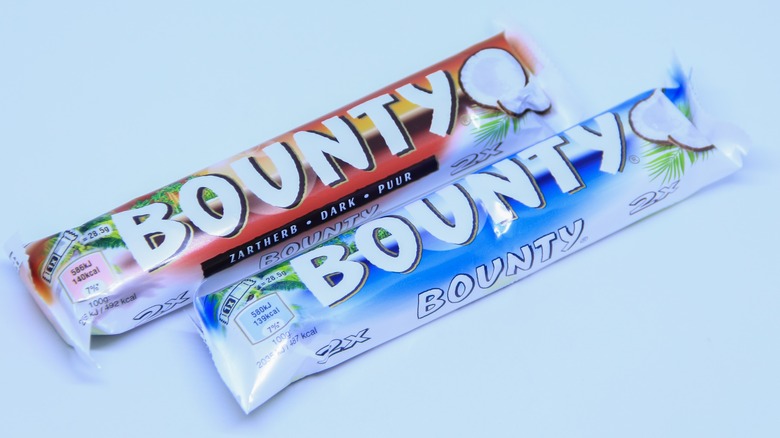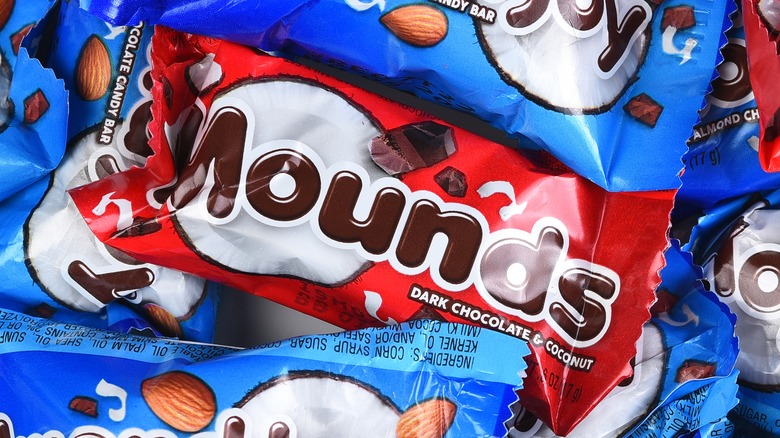Bounty Candy Vs Mounds: What's The Difference?
Like peanut butter and chocolate and caramel and chocolate, coconut and chocolate is an iconic candy bar combo. Even though the pairing may be a little more divisive, Almond Joy, Mounds, and Bounty bars have their dedicated fans. Mounds and Bounty are undeniably similar, with their pasty coconut filling and chocolate coating. The biggest difference is that Mounds is an American candy and Bounty is from the U.K.
Although less popular than its milk-chocolate-and-almond counterpart, Almond Joy, Mounds is readily available in the U.S. However, Bounty is an international product and is relatively harder to find in the States. You can buy Bounty bars online at Walmart (through distributor Parthenon Foods) or on Amazon. Just don't expect to see Bounty bars in person at your local grocery store.
Bounty and Mounds share similar ingredients such as sugar, coconut, cocoa, cocoa butter, milk fat, emulsifiers, and glucose syrup. These simple candy bars can be recreated with our homemade Mounds recipe (which could easily double as a copycat Bounty recipe) that only requires coconut, condensed milk, and chocolate.
Bounty bars are a divisive British treat
Bounty was launched in 1951 by Mars in the U.K. Bounty bars feature a shredded coconut filling coated in chocolate. Milk chocolate is the original flavor, but it is (or was) also available in dark chocolate — similar to Mounds. Comparisons of Bounty and Mounds note that Bounty bars are thicker and filled with more coconut that is both whiter in color and finer in texture. The rippled chocolate coating is creamier, reflecting the difference between British and American chocolate that stems from a higher fat content. Although Bounty is still available in the U.K., recent actions by its manufacturer have made fans of the candy worry for its survival.
In 2022, Bounty was removed from Celebrations tubs — variety containers of mini-sized candies, including Snickers, Maltesers, Milky Way, and others. In a press release, Mars stated that 39% of Brits wanted the bar banished from the tub, and many would be irritated if only Bounty remained after the rest of the candies were picked through. The solution? A trial run of Bounty-free Celebrations tubs (which has since ended). Also in 2022, Mars temporarily delisted the dark chocolate version of the bar due to operational reasons. It is unclear if dark chocolate Bounty will return, but the milk chocolate bars are still available.
Mounds' rich history
Mounds bars predate Bounty and have a rich history. Mounds was invented in 1920 by Peter Halajian's candy business, the Peter Paul Manufacturing Company. Armenian-born Halajian moved to the United States in 1890, where he opened multiple candy shops before starting Peter Paul with five business partners in 1919. The Connecticut-based company became a success when it introduced Mounds in 1921. The original Mounds was similar to today's — a sweet coconut filling coated in dark chocolate. However, in the beginning, each Mounds bar was completely handmade. The success of the chocolate bar led the company to buy more machinery and production space in Naugatuck, Connecticut.
Mounds even survived the challenges of World War II. The low supply of ingredients forced the company to discontinue its less successful candies and use what resources it had to continue Mounds production. The U.S. military became Mounds' biggest customer during the war and gave bars to American soldiers. Mounds' sibling, Almond Joy, was introduced in 1946. (Almond Joy is different from Mounds because it has a milk chocolate coating and a single almond on each piece). The Peter Paul Manufacturing Company was acquired by the Hershey Company in 1988. Up until 2007, the Connecticut factory in Naugatuck was still producing Mounds and Almond Joy.


